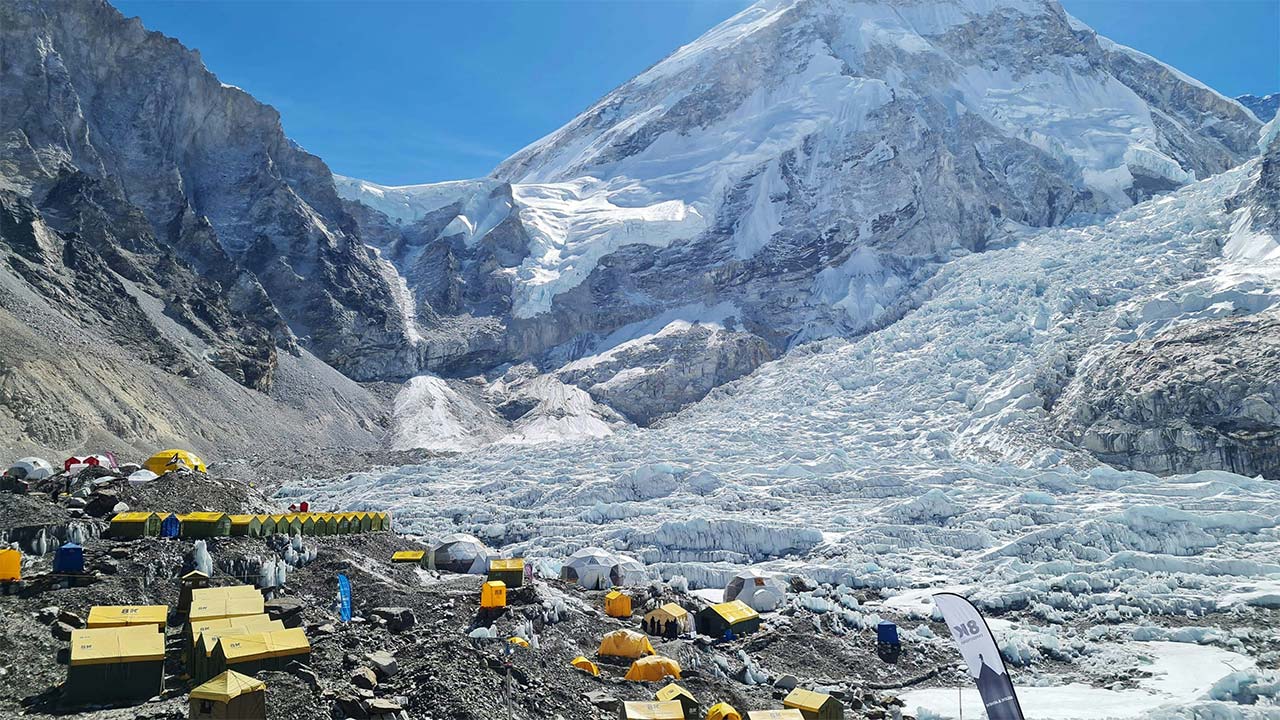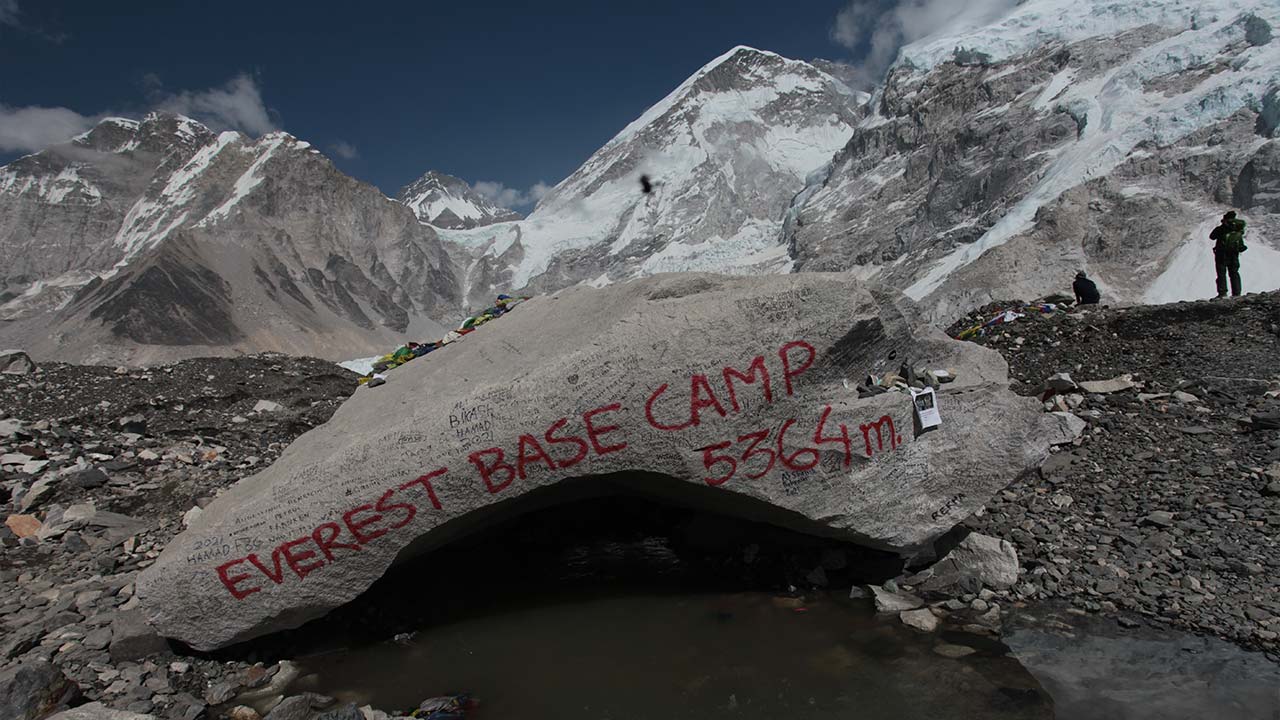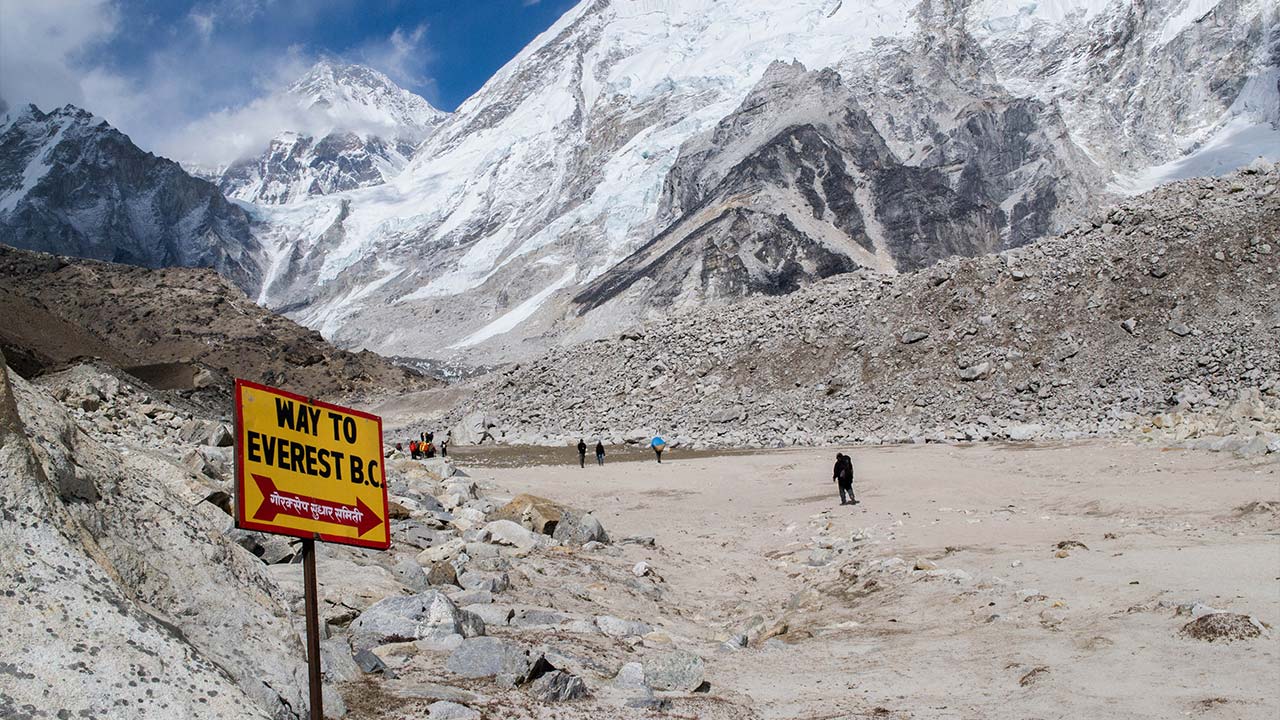The Everest Base Camp trek is not just another hike. The Everest Base Camp trek is a dream of many trekkers who crave the raw soul of the Himalayas. Despite its beauty, the path to base camp is rarely gentle. Between exhaustion and awe, between altitude sickness and beauty, still one question raises in every traveller's mind: Is Everest Base Camp risky?
Introduction: Where Adventure Meets Danger
With each passing year, thousands of souls journeying from across the continents strap themselves in for the climb to Everest Base Camp (EBC). The journey extends roughly 130 kilometers round-trip. It is just not another hiking route; it is a dream trail that will take you through ancient Sherpa villages, prayer flags fluttering to welcome trekkers and snowy high peaks touching the sky. Despite the amazing beauty, there is still a question almost every trekker asks before booking the flight tickets to Lukla: Is Everest Base Camp risky or not?
Answering the question is not so simple. The Everest region can be uncertain. In a fleeting moment, the sun warms your shoulders, and before you know it, freezing winds remind you how small you are among the giants. On every step you move higher, the oxygen gets thinner. Our body has to learn how to keep going when the lungs beg for more air. In this trail, even the fittest trekkers feel the pressure somewhere along the way.
Exactly, this is what turns a climb into an unforgettable experience. Dangers like altitude sickness, fatigue and sudden weather changes are ever-present. Still, the rewards of this journey make every step worthwhile. Standing beneath the shadow of the world's tallest peak, surrounded by the stillness of the Himalayan peaks, is something that language can scarcely express.
So, is the Everest Base Camp trek dangerous? It could be a little bit dangerous if you are not prepared for the difficulty aspects of the journey. Beyond everything else, it leaves an unforgettable mark that the best view often comes after the toughest climbs.

The Rugged Land and Thin Air Challenge
The journey to your Everest base camp trek starts the instant when the small plane you ride touches the ground at Lukla Airport. The tiny airstrip clinging to the slope immediately evokes your thought that it is not a normal trip. Every step you take will take you deeper into the heart of the Himalayas, across swinging suspension bridges and stone steps. The trek follows trails carved through forest and ancient villages, revealing the Himalayan hidden charm.
At first, you may feel effortless because of the crisp mountain air, friendly locals and yak carrying supplies make it look simpler. However, when you climb up higher, the trails start to change. Slowly, the trees thin out, the air gets colder and each breath grows heavy and shallow. When you reach Namche Bazaar or Dingboche, even a few minutes of short uphill walks can make your chest race with excitement.
At this time, every trekker truly starts to know what altitude means. With every upward step, the air grows scarcer and your body has to fight to adjust to that surrounding. It is not only about being physically fit, but it's also about how well your body can adapt to this environment. So this is the reason why the acclimatization days are included in trekking itineraries. You should take short hikes and rest at night, which greatly helps your lungs and muscles adjust to the climb at altitude.
The terrain can be rough, rocky and at times unforgiving, which demands every ounce of stamina until you look up, and there you see Ama Dablam, silver light glistens on the peaks, clouds dance around Lhotse, and Everest watches from afar. Suddenly, your every struggle feels worth it. The mountain does not just challenge you, but the peaks will remind you how alive you really are.
What is the Hardest Day of the Everest Base Camp Trek?
Every trekker remembers a day on the Everest trails that truly tests their limits. You will be unable to forget that one day, when your legs hurt, you can barely breathe, and your mind says this may be enough. For most of the trekkers, that day arrives when travelling from Lobuche to Gorak Shep and then pressing onward through the rugged path to Everest Base Camp (5,364 m).
This leg of the journey is very long and tiring. It will take roughly eight hours of steady walking along a rugged, uneven path strewn with glacial rocks and dust. The surroundings feel unlike anywhere else, with silver-grey glaciers, a wind that tears through the silence with icy fingers and a silence so heavy, you can almost hear your heartbeat over the wind and snow. Every step toward base camp grows more exhausting, yet the idea of standing under the towering peak drives you onward.
The colourful prayer flags of Everest Base Camp greet you and for a moment, the fatigue of the arduous journey fades into the mountains' embrace. A wave of joy, disbelief, and pride collide in a rush of emotion as you take place that most people only see in their dreams.
The next morning, a new challenge awaits you to ascend to Kala Patthar (5,545 m) to witness the sun rising over the world's highest peak. It may be a short ascent, but it's relentlessly steep, with freezing winds biting before the first light of the day. You feel the burn in every breath, the thin air biting your lungs, but the sight awaiting above silences all exhaustion. In the soft glow of morning, Everest feels less like a distant giant and more like a living presence within arm's reach.
These may be the toughest days of the journey, yet also the most stunning days and it also sets a reminder that in the Himalayas, every ache carries its own kind of beauty.
Pushing Limits: Altitude Fatigue and Energy Drain
No matter how perfect your preparation or strength, one unseen force that challenges everyone on the Everest Base Camp Trek is altitude. The higher you climb, the more your body senses the shift in oxygen levels. With every meter gained, your breath shortens, your pace falters and even small action takes surprising effort.
This is where your body may feel the effects of altitude sickness, also known as the Acute Mountain Sickness. Altitude sickness can affect anyone, from seasoned trekkers to beginners. Altitude sickness often begins with mild symptoms like headache, feeling sick, nausea, lack of appetite and poor sleep. Altitude sickness can turn into a severe condition if trekkers ignore it. So, the golden rule in the Himalayas is simple: you should always listen to your body.
Around one in three people on the trek experience some of the signs of altitude sickness during the journey. There is some good news that it can be managed. You should take it slow, stay hydrated, and follow the high-hike sleep slow principle, which helps to adjust our body naturally. The bulk of trekking itineraries incorporate an acclimatization period in Namche Bazaar and Dingboche, which helps to adapt without any risk.

After that, there is a complete physical tiredness due to long walking hours, cold and flights, and sometimes there is a loss of hunger, which makes consuming food exhausting. Your energy is drained faster than you expect during trekking six to eight hours daily at high altitude. So well balanced, meals, proper rest and consistent pacing are just as important as reliable boots and insulating clothes.
The danger is real, but it is not driven by fear; it is about acknowledging its power, showing respect for the mountains, your capacities, and your physical signals. With conscious awareness and steady patience, most of the trekkers not only withstand the altitude but truly excel.
Is It Possible to Reach Everest Base Camp Without Training?
It ranks as one of the most asked questions that most people ask before registering for trek: “Can I really do Everest Base Camp without training? Practically speaking, yes, many have. The honest answer is this: your trek will be more enjoyable if you prepare even a little in advance.
The Everest Base Camp trek journey is meant for trekking, not racing or cliff climbing; it is a prolonged, steady trek through high-altitude terrain. Though spending six or more hours on the trail every day, over the course of nearly two weeks, is not an activity most people engage in every day. Lacking even basic stamina and strength, you begin to experience knee soreness, your back begins to protest, and the happiness of the adventure can be overshadowed by sheer tiredness.
You don’t need to have elite running skills; even a short term of preparation can greatly improve your experience. You can train by tackling gentle inclines with a backpack, skipping the elevator for stairs and taking short weekend treks. Simple exercises like jogging, cycling, or brisk walking can help build your lungs and stamina. Training for 4 to 6 weeks before the trek can help your body get ready for a slow uphill walk.
But here is the truth that the Everest Base Camp trek is not just about physical fitness; it is about mental strength, believing you can take one more step even when you are tired. Many fittest people turn back halfway, while others with average fitness reach the end because they refuse to quit. If you train your body and keep a strong mindset, then you can absolutely reach base camp - one steady step at a time.
Can a Normal Person Climb Everest Base Camp?
That's the true beauty of this trek, which brings you rewards in a way that we cannot describe. You do not need to be an expert mountaineer or train for a whole year to make it to Everest Base Camp. The trek trail welcomes everyone: students, teachers, parents, office workers and retirees, all sharing the same dream of standing beneath the tallest mountain on Earth.
You will see people of every age trekking along the trail. You will see trekkers in their twenties, bursting with energy and others in their sixties, walking steadily, all with their own reasons for the journey. It does not matter how old you are or how strong you are; it is all about your attitude. It is not about how fast you go because the mountain values patience and perseverance.
Local sherpas advise trekkers to walk slowly because it is the best way to reach their goal. In the end, the trek teaches one lesson that it is not about speed or racing. The journey is about pacing yourself, one step at a time and enjoying the scenery around you.
People with everyday jobs, little training experience and busy schedules still reach Base Camp every year. They reach base camp not because of superhuman fitness, but because they stay consistent, focused and keep going through challenges.
Smart Trekking Tips For Minimizing Risk
As we know, every adventure comes with many risks. Smart trekkers are well aware that preparation turns fear into confidence. The Everest Base Camp trek is no different. A proper approach can minimize risks and turn your journey into a safe and memorable adventure.
Here are a few tried and true ways to keep dangers low and spirits high :
- Choose a Trusted Trekking Agency: You should not compromise while choosing the trekking agency. If you choose a good agency will facilitate you with licensed guides, reliable porters. You can also get emergency support like oxygen cylinders and satellite communication. Local knowledge of them creates the difference between a smooth trek and a stressful one.
- Respect Acclimatization: The slower you move, the safer your journey will be. Spending an extra night at Namche Bazar (3,440m) and Dingboche (4,410m) to let your body adapt to the Himalayan environment. Rest days are not a waste day; they are what help trekkers to reach Everest Base Camp safely.
- Get Proper Insurance: You should book a high altitude trekking insurance that covers helicopter rescue up to 6,000 meters. It is mainly mandatory for high-altitude trekkers. This will be one of the things that you think you never need. This will be helpful for every trekker if something goes wrong.
- Eat enough and Stay Hydrated: Lots of trekkers lose their appetite at high altitude. Your body needs some calories to stay strong and warm. You should frequently drink plenty of water, around 3 to 4 liters of water, even if you are not hungry.
- Pack Smartly: You should pack your bags lightly and mindfully. You should add good boots, layered clothing, gloves, a vest and a sleeping bag rated for cold nights. You should not overpack, but don't skimp on warmth either.
- Always Check the Weather: You should avoid trekking during the heavy monsoon ( June to August) or in peak winter (January to February). Always choose the best season in spring (March to May) and autumn (September to November). This season offers you clear skies and safer trails.
The most important thing is that you should listen to your body. If you have a problem with your health or feel dizzy, extremely tired, or breathless, it is okay to take an extra rest or slow down. Your health is the priority because Everest isn't going anywhere.
In summary, smart trekking is not just about eliminating all the risks, but it is about how you can handle them. When you are well prepared and respectful for the mountain, you won't feel dangerous. You can feel them alive, vast and humbling.

Conclusion: An Adventure Worth Every Step
So, is Everest Base Camp risky? Yes, it is a risk, but not in the way most people think. The true challenge is not climbing the mountain, but listening to your body and finding calm in the hard moments. The real risks are thin air, tiredness and changing weather, but these are factors that make your journey special and meaningful.
For every struggle, there is something beautiful waiting ahead: the gentle kindness of a Sherpa's warm cup of tea, the laughter echoing through the teahouse or that first glimpse of Everest shining in the morning sun, rewarding you with unforgettable memories.
The base camp trail is special not just for the destination, but for the lessons you discover along the journey. On the trail, you will find humility, patience and a calm strength that grows with your every hard step forward.
When you finally stand beneath the fluttering prayer flags, encircled by snow, chill and stillness, you feel that every challenge, every risk was worth it. Tiredness fades, cold fades and all that remains is quite pride.
